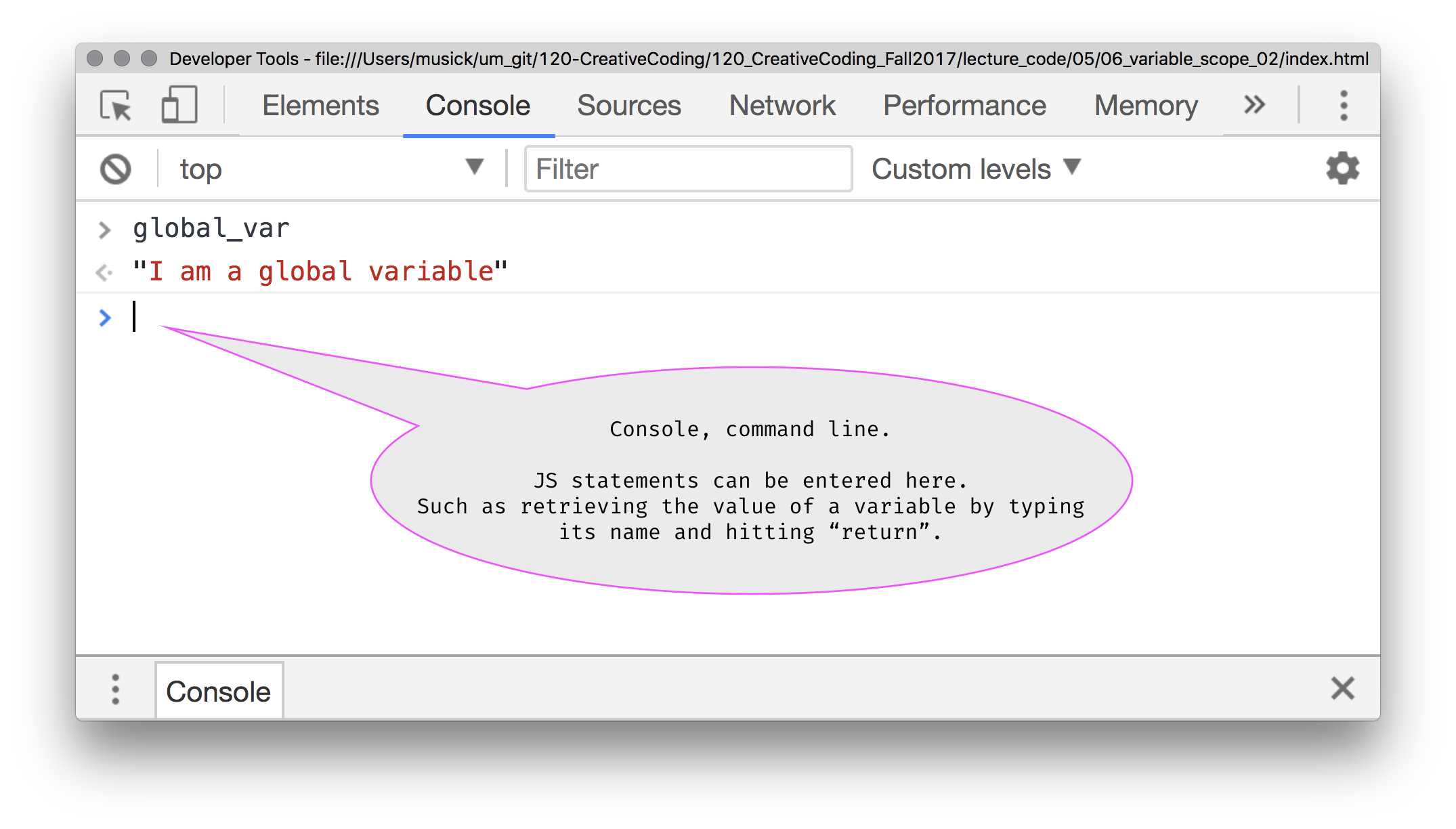Variable Scope
One critical concept for you to understand, is that of “variable scope.” A variable’s scope is the area of code where a variable is available for referencing and using.
There are generally considered two levels of variable scope in JavaScript; global scope and local scope.
Local Scope
Let’s start with local scope with variables. A variable that is defined within a function, for example, your setup() function, will ONLY be available inside of that function.
For example,
function setup() {
let local_var = 3;
// we can now use "local_var" in here.
ellipse( local_var, local_var, local_var );
}
// however, if we try to use local var outside of the function
// we will run into an "Uncaught Reference" error.
console.log( local_var );
| [ Code Download ] | [ View on GitHub ] | [ Live Example ] |
Again, the variable local_var which was declared inside of the setup() function, is ONLY available to the setup() function. This is the “variable’s scope.”
The above code, if executed, would return an error; saying something like, “Uncaught ReferenceError: local_var is not defined at sketch.js:9”.

Global Scope
Variables defined outside of a function, are said to have “Global Scope”. That is, they are available anywhere in your JavaScript code, even between JavaScript files (we are not there yet, but keep this in mind for later).
In the following example, the variable global_var is available inside both the setup, and draw functions, as well as outside of all functions.
| [ Code Download ] | [ View on GitHub ] | [ Live Example ] |
Snooping on Global Variables
Since Global variables are available everywhere, we can access them using a browser’s JavaScript console.
Notice in the above example, how there is a new tab, labeled, “JS Console”. If you select that tab, there will be a carrot > , on a grey line. With you mouse, click in this grey area, then type global_var and hit “return”. You will see the string “I am a global variable” printed in the console.
When working on your own sketches, you can do the same thing, by opening your Browser’s JavaScript Console. Then working and “snooping” in there.

You can read more about scope in JS from Microsoft’s JavaScript Documentation Page
Problems with p5
There are few problems with regard to scope, that we are going to run into frequently with p5. Specifically, there will be an issue that arises when you want to use p5 functionality, assigned to a global variable. You cannot access p5 functionality, outside of the scope of p5 functions.
What does this mean???
Say for example, you want to create a variable that stores a Number. This Number is suppose to be 25% of the width, as it is a location you want to draw an ellipse at.
Since we just learned about the p5 reserved name variable width, you might assume you could simply do something like the following;
let quarter_width = width * 0.5;
function setup() {
createCanvas(400, 200);
}
function draw() {
ellipse( quarter_width, 20, 40 );
}
The problem is that we cannot reference the p5 variable width, outside of the setup() or draw() functions. (It would also cause a problem, as we are trying to use the variable width before we have set the “width” of the canvas with createCanvas())
If we simply move it inside of the setup() function, we will be able to successfully assign it the value of width * 0.5. This might look like;
function setup() {
createCanvas(400, 200);
let quarter_width = width * 0.5;
}
function draw() {
ellipse( quarter_width, 20, 40 );
}
In this example, we will still get an error, as now, the variables scope will be limited to the setup() function only. It will not be available to the draw() function.
So, couldn’t we just move the variable assignment to the draw() loop?
function setup() {
createCanvas(400, 200);
}
function draw() {
let quarter_width = width * 0.5;
ellipse( quarter_width, 20, 40 );
}
This could would work, and is completely legal. However, it is inefficient, as we are reassigning quarter_width every frame. There might also be a situation, where we want to be able to re-assign quarter_width later in the draw() function. In which case, we would need to have its assignment still occur outside of the draw() function.
To solve this problem, we simply need to separate our declaration statement from our assignment statement. If we declare the variable globally, we can then assign it within setup(). This gets around the issue of calling p5 functionality outside of p5 functions.
We can then also use the variable in draw() thereby getting around the scope issue. Since the variable is “global”, we can assign its value in setup() and reference it in an entirely different function.
This would look like;
| [ Code Download ] | [ View on GitHub ] | [ Live Example ] |